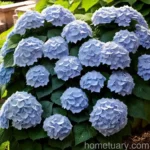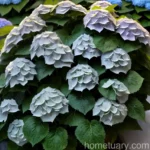All About Bigleaf Hydrangea (Hydrangea macrophylla ‘Hortmahar’ EVERLASTING HARMONY)
Introduction
Hydrangea macrophylla ‘Hortmahar’ EVERLASTING HARMONY, commonly known as the bigleaf hydrangea, is a beautiful and popular flowering shrub that is favored for its large, showy blooms and ease of care. As a plant scientist, I am excited to delve into the specifics of this stunning plant, covering everything from its culture and uses to its care requirements and potential issues. In this comprehensive guide, you will find valuable information on the bigleaf hydrangea, including its characteristics, cultivation, maintenance, and more.
What is Bigleaf Hydrangea (Hydrangea macrophylla ‘Hortmahar’ EVERLASTING HARMONY)?
The bigleaf hydrangea, Hydrangea macrophylla ‘Hortmahar’ EVERLASTING HARMONY, is a cultivar of the Hydrangea macrophylla species. It is renowned for its large, vibrant flowers that are clustered together in magnificent blooms. The EVERLASTING HARMONY variety is particularly cherished for its long-lasting blossoms and stunning color variations. With its ability to thrive in various environmental conditions, the bigleaf hydrangea is a sought-after addition to gardens and landscapes around the world.
Key Takeaways
Before we delve into the specifics of bigleaf hydrangea care and cultivation, let’s summarize the key takeaways about Hydrangea macrophylla ‘Hortmahar’ EVERLASTING HARMONY:
- Scientific Name: Hydrangea macrophylla ‘Hortmahar’ EVERLASTING HARMONY
- Common Name: Bigleaf hydrangea
- Variety: EVERLASTING HARMONY
- Features: Long-lasting, vibrant clusters of flowers
- Cultivation: Adaptable to various growing conditions
- Uses: Gardens, landscapes, cut flowers
- Challenges: Potential diseases and pests
With these key points in mind, let’s explore the various aspects of bigleaf hydrangea, ranging from its cultural requirements to its unique features and potential issues.
Culture
Water
Bigleaf hydrangeas require consistent moisture to thrive. The soil should be kept evenly moist, especially during dry periods and hot weather. Regular watering is essential, but care should be taken not to overwater, as waterlogged soil can lead to root rot. Adding a layer of mulch around the base of the plant can help retain soil moisture and regulate the temperature.
Sunlight
When it comes to sunlight preferences, bigleaf hydrangeas benefit from dappled or filtered sunlight, especially in regions with hot summers. While they can tolerate some morning sun, they generally prefer partial shade to protect their delicate blooms from scorching heat. In contrast, too much shade can result in reduced flowering, so finding the right balance is crucial for optimal growth and bloom production.
Fertilizer
Applying a balanced, slow-release fertilizer formulated for flowering shrubs in spring can support the vigorous growth and abundant flowering of bigleaf hydrangeas. Avoid high-nitrogen fertilizers, as they can promote excessive leafy growth at the expense of flower production. Additionally, incorporating organic matter into the soil during planting can provide essential nutrients for the plant’s development.
Soil
Bigleaf hydrangeas thrive in well-draining, fertile soil with a slightly acidic to neutral pH. Amending the soil with organic matter, such as compost or peat moss, can improve its structure and fertility, enhancing the overall health of the plant. Soil moisture is a critical factor, so ensuring proper drainage while retaining adequate moisture is essential for the success of bigleaf hydrangeas.
Pruning
Pruning Techniques
Pruning bigleaf hydrangeas is an important aspect of their maintenance, as it can promote healthy growth and prolific flowering. Care should be taken to prune at the right time to avoid inadvertently removing flower buds. Generally, it is recommended to prune immediately after flowering, as this allows ample time for the development of new flower buds for the following season. Removing dead or weak wood, as well as shaping the plant to maintain its desired size and form, are key objectives of pruning bigleaf hydrangeas.
Pruning Season
The ideal time for pruning bigleaf hydrangeas is shortly after they finish flowering, typically in late summer. This timing ensures that the plant has sufficient time to develop new growth and flower buds for the next blooming cycle. However, in regions with harsh winters, it is advisable to avoid pruning too late in the season, as this can leave the plant vulnerable to cold damage.
Propagation
Propagation Methods
Bigleaf hydrangeas can be propagated through various techniques, including:
- Softwood Cuttings: Softwood cuttings taken in spring and early summer can root relatively quickly under proper conditions, giving rise to new plants with characteristics identical to the parent.
- Layering: Air layering or simple layering can be employed to encourage the development of roots on a stem or branch while it is still attached to the parent plant.
- Division: Dividing mature clumps of bigleaf hydrangeas can yield new plants, each with its own root system, which can then be transplanted to new locations.
Propagation enables the multiplication of favored cultivars and the expansion of bigleaf hydrangea displays in gardens and landscapes. Additionally, it serves as a means of preserving exceptional genetic traits and cultivar characteristics.
Container Popularity
Bigleaf hydrangeas are well-suited to container gardening, offering versatility and eye-catching beauty in outdoor spaces, such as patios, balconies, and entryways. The flexibility of growing them in containers allows for easy mobility and the opportunity to showcase their stunning blooms in various settings. Choosing a large, well-draining container and using a high-quality potting mix are crucial for ensuring the health and vitality of bigleaf hydrangeas in containers.
Common Diseases
Bigleaf hydrangeas are susceptible to certain diseases, including:
- Powdery Mildew: A fungal disease that manifests as a powdery white coating on the leaves and flowers, often caused by poor air circulation and high humidity.
- Cercospora Leaf Spot: Identified by circular, dark spots with distinctive borders on the leaves, this fungal disease can affect the overall health and appearance of the plant.
- Botrytis Blight: Also known as gray mold, this fungal disease thrives in cool, humid conditions and can lead to the development of grayish mold on flowers and foliage.
Disease Diagnosis
Diagnosing diseases in bigleaf hydrangeas involves careful observation of the plant’s symptoms, including leaf discoloration, spotting, and wilting. Personal inspection and, if necessary, professional analysis can help accurately identify the specific disease affecting the plant, enabling targeted and effective treatment. Implementing proper cultural practices, such as adequate spacing, proper watering, and airflow management, can aid in disease prevention and mitigation.
Common Pests
Several pests may pose potential threats to bigleaf hydrangeas, including:
- Aphids: These small, soft-bodied insects can congregate on tender new growth, sucking sap from the plant and causing distortion and stunted growth.
- Spider Mites: Known for their fine webbing and ability to thrive in hot, dry conditions, spider mites can cause stippling and discoloration of leaves, weakening the plant over time.
- Scale Insects: Their characteristic waxy covering protects them as they feed on plant sap, potentially causing significant damage and reducing the plant’s vigor.
Preventing and managing pest infestations often involves a combination of measures, such as regular monitoring, physical removal of pests, and the application of appropriate horticultural oils or insecticidal soaps if necessary.
Botanist’s Tips
As a botanist, I offer the following tips for successfully cultivating and enjoying bigleaf hydrangeas:
- Selecting Cultivars: Choose cultivars that align with your desired color, growth habit, and site conditions, considering factors such as flower color, reblooming capabilities, and cold hardiness.
- Soil Maintenance: Regularly assess and improve the soil structure and fertility to provide an optimal growing environment for bigleaf hydrangeas.
- Bloom Enhancement: Adjust soil pH to influence flower color, knowing that acidic soils generally yield blue blooms, while alkaline soils promote pink blooms.
- Environmental Considerations: Be mindful of potential environmental stressors, such as extreme heat, drought, and cold, and take necessary measures to protect and support the plants during challenging conditions.
Fun Facts
Delving into the world of bigleaf hydrangeas unveils several fascinating and delightful facts:
- Color Transformation: The flowers of some bigleaf hydrangea cultivars can undergo dramatic color changes based on soil pH, with blooms shifting from pink in alkaline soil to blue in acidic soil.
- Reblooming Varieties: Certain cultivars, such as EVERLASTING HARMONY, possess the ability to produce multiple waves of blooms throughout the growing season, extending the visual delight they offer.
- Flower Structure: The intricate and lacy appearance of bigleaf hydrangea blooms adds an enchanting allure to their overall presentation, captivating the eye and evoking a sense of elegance.
Links to External Resources
To further expand your knowledge and appreciation of bigleaf hydrangeas, I recommend exploring the following external resources:
- American Hydrangea Society: A comprehensive source of information on hydrangeas, including species profiles, cultural tips, and gardening insights.
- The Spruce – Growing and Pruning Bigleaf Hydrangeas: An informative guide detailing the cultivation and pruning of bigleaf hydrangeas for optimal health and blooms.
- University of Florida IFAS Extension – Hydrangea Pest Management: A valuable resource offering insights into the identification and management of pests affecting hydrangeas and other ornamental plants.
By immersing yourself in these resources, you can gain a deeper understanding of bigleaf hydrangeas and refine your horticultural practices to ensure the flourishing of these enchanting plants.
In conclusion, the bigleaf hydrangea (Hydrangea macrophylla ‘Hortmahar’ EVERLASTING HARMONY) stands as a captivating and versatile addition to gardens, able to enchant with its abundant, long-lasting blooms while requiring mindful care to support its health and beauty. With a wealth of knowledge about its culture, uses, care requirements, and unique characteristics, you are empowered to introduce and nurture this remarkable plant in your own outdoor spaces, enriching your surroundings with its captivating presence.
Remember, as with any plant, the joy of cultivating bigleaf hydrangeas lies in the journey of discovery and the gratifying experience of witnessing their splendor unfold in the garden.
Happy gardening!















